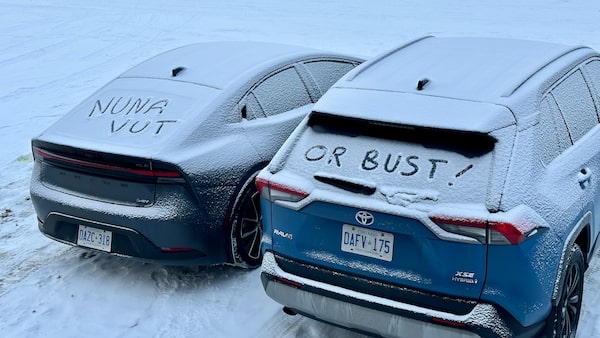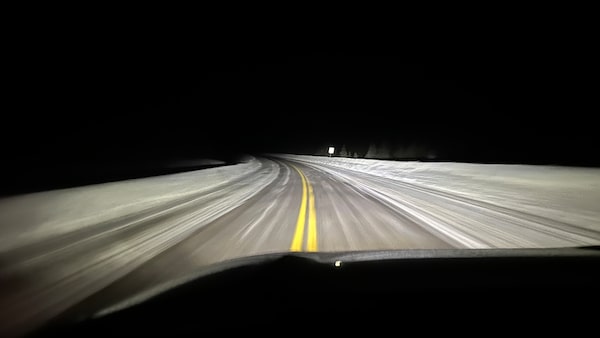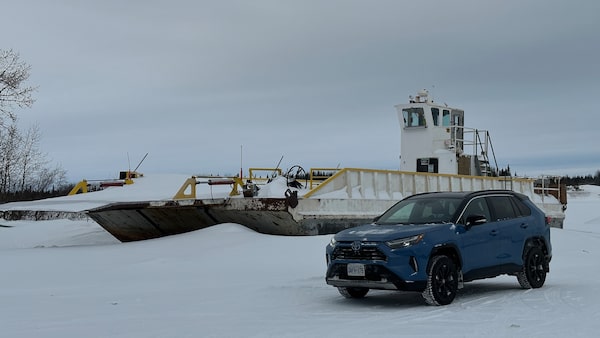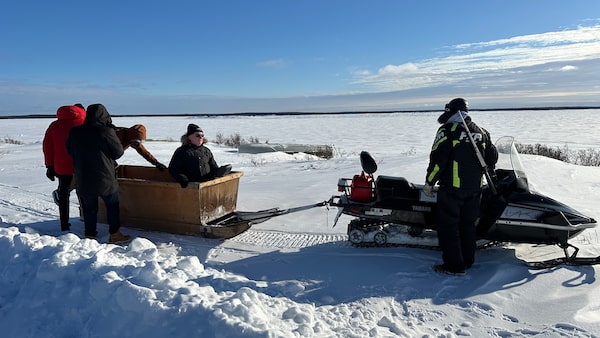
The Toyota Prius and a Toyota RAV4 Hybrid at the entrance to Chisasibi.Mark Richardson/The Globe and Mail
Let’s just be clear, right off the top. There is no road that crosses into the territory of Nunavut from anywhere in Canada. There used to be a winter ice road north of Yellowknife that stretched up to a Nunavut diamond mine, but that melted away years ago when the mine closed. You cannot drive a car to Nunavut.
Except, you sort of can.
That’s because all of the islands in James Bay, almost 1,400 kilometres by road north of Toronto, are considered part of Nunavut. And some of them are tantalizingly close to land.

Driving at night in the RAV4 from Radisson to Chisasibi.Mark Richardson/The Globe and Mail
So why not drive through Ontario and Quebec to one of the Cree communities on the eastern shore of James Bay, and then travel on the ice to a nearby island? It seemed like a good idea at the time, debated over beers with friends, and that’s how we found ourselves at the base of the Billy Diamond Highway, checking in at the road’s security hut for the long journey north.
Review: Driving Toyota Prius and RAV4 hybrids on the long road to James Bay
The James Bay Road was renamed in 2020 for the late Grand Chief of Quebec’s Cree Nation, a successful businessman who fought to enshrine Indigenous rights in the Canadian Constitution. It’s 620 kilometres of wide, paved road, built in the early 1970s and designed to carry heavy truck loads up to the hydro town of Radisson, for the construction of the massive dams of the James Bay Project. The road is open all year, though it’s officially closed on winter nights from 8 p.m. to 8 a.m. Driving is safer that way.
Sealskin Island, Nunavut.Mark Richardson/The Globe and Mail
The four of us signed in and were given an information sheet that told us of the various waypoints along the route. There aren’t many, despite a distance farther than the drive between Toronto and Montreal. Four junctions for roads heading west to the four Cree communities on James Bay, two roads headed east – one of them for an ominous 666 kilometres of gravel to more dams and with only a couple of hunting camps for services – and one truck stop halfway in the middle of seemingly nowhere. That’s where you can buy gas and food, and sleep the night if needed, at kilometre 381, and yes, we would need gas.

The Prius and RAV4 near the shore of James Bay at Chisasibi.Mark Richardson/The Globe and Mail
We were driving a Toyota Prius and a Toyota RAV4 Hybrid. Both were frugal with fuel, but the Prius had a range of about 580 kilometres on a full tank, and that wouldn’t be enough to leave the gas station in the nearby town of Matagami and reach Radisson without filling up along the way.
In any case, we weren’t going to Radisson. We were turning west, 20 kilometres before the town, and driving an extra 80 kilometres to Chisasibi, the farthest north of the road-accessible Cree communities.
I’ve driven this highway twice before. Both times, the temperature was much colder at around minus-20 degrees, and both times we had to be wary of animals along the way, attracted to the asphalt and its ice-melting salt. This year, the caribou were far to the east, shunning the taiga forest burned in last summer’s wildfires. Instead, we saw flocks of ptarmigans, known as white birds, strutting around on the highway and oblivious to our vehicles. We swerved around them as best we could, but one swooped low in front of the RAV4 and seemed to explode in a cloud of feathers on impact. None of the other trucks on the road slowed or changed course to avoid them and the highway was sometimes littered with small, white carcasses.

The RAV4 beside the ferry to Fort George island, near Chisasibi.Mark Richardson/The Globe and Mail
Time passed quickly on the highway, with few distractions from the scenery of low hills and endless trees, both green and burned. Snow was thick on the ground, but the road and sky were mostly clear. We changed drivers every two hours, chatted between the vehicles on the walkie-talkies we’d brought along for safety, and listened to satellite radio. Our cellphones were far from any reception, even with the WiFi hotspots available through the two Toyotas.
The long highway is smooth and well maintained, but it’s taken a beating over the years from the heavy truck traffic and sub-Arctic weather, and there are many patches of rippled or undulating asphalt that would be dangerous to drive on at speed. It has a reputation for being lightly policed, though we saw cruisers headed in both directions, so that didn’t hold up. We were happy to see them, in any case. We travelled with blankets and survival equipment and rations – lots of chocolate bars – in case of being caught in a storm, but even in the clear weather, it was good to know help would be at hand if something went wrong.
The enormous spillway from the Robert Bourassa dam near Radisson.Mark Richardson/The Globe and Mail
Occasionally, there were rudimentary hunting camps beside the road, and we saw maybe two dozen vehicles along the entire route. We were warm and comfortable inside the hybrids, but Chisasibi was still a welcome sight when we rolled into town, eight hours after starting up the road. It’s the largest of the Cree communities and has grown considerably in size since I last visited in 2011; the population of around 5,000 people is about the same, but new housing means many residents are not so crowded into family homes as they used to be.
We were still in Quebec, of course, and not quite at Nunavut. We stayed a night at a local auberge and then drove out to the far end of the community’s peninsula of land. The gravel road was totally white, cleared by huge snowcats so it seemed like a rolling winter chute for the cars. Finally, a further 15 kilometres west of town, a parking lot and picnic tables marked the true end of the road. The Toyotas were blocked by walls of snow, and beyond, the vast, flat bay itself. Islands of dark rock in the white ice taunted us, and if one of those snowcats were to push aside the snow to create a path out to one of them, we could surely have driven all the way to Nunavut. But the way was blocked by the walls of cleared snow, and sensibly so.
No matter. We’d arranged through Chisasibi’s tourism office to meet there with Steven Sam, a local resident who owns both a snowmobile and a trailer large enough for four passengers. We removed a headrest from each of the Toyotas, so at least part of the vehicles would make it to Nunavut, and clambered into the trailer. The representative from Chisasibi Tourism, Thomas Sealhunter, met us at the shoreline and watched with bemusement as we prepared to fulfill our quest.

Mark Richardson’s drive partners join him in the snowmobile trailer before the ride over to Sealskin Island.Mark Richardson/The Globe and Mail
“This is important,” I told him. “This is the road to Nunavut, which is just over there.”
Sealhunter pursed his lips together and kind-of nodded. “It’s understandable,” he said after a while, politely. “I guess.”
And so we carried the headrests for three more kilometres across the metre-thick ice to a small clump of rock called Sealskin Island, officially in the jurisdiction of Nunavut. Sam carried a rifle in case of wolves but none were there to threaten us. Actually, nothing was there. Just some driftwood and snow and rock and a wind that weakened as we walked the island’s short length and width and took photos for posterity.
We’d made it. We weren’t quite sure why, but this road trip was a journey of exploration that left each of us feeling we’d achieved something worthwhile. Quite what that was, we weren’t yet sure. If I ever figure it out, I’ll be sure to tell my grandchildren.
Toyota provided the vehicles and covered basic expenses for the trip. Content was not subject to approval.